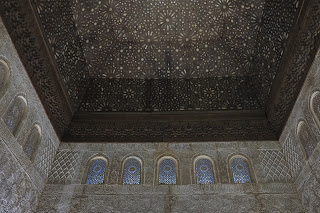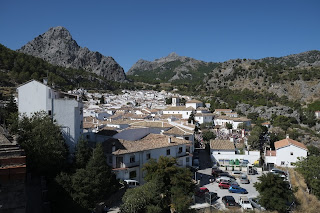So I came back to Spain for the second time this year. I hadn’t intended to come back so soon, actually. It was merely by association. I had asked for three weeks off in October to travel (Thanks, Scott!), but in my uninspired procrastinating ways I hadn’t made any plans until a few weeks ago. My pattern of taking trips during shoulder seasons in either April or October usually limits me to areas of good weather during this time. So, I had decided on Morocco, a place that I have always wanted to see but years ago I was too cheap to fly to. And since I made up my mind to go to North Africa, it was always on my mind to lump in this special southern region of Spain. I had heard so much about places like Seville and Granada. And so I thought, why not spend a few more weeks to burn through my Spanish textbook again over more tapas. Or perhaps, forget about the Spanish textbook.
So far I’ve been to Madrid, Barcelona, and part of the north in Bilbao and the beautiful San Sebastian. But the southern region of Spain, called Andalucia, is quite unique in its own historical beauty (I had no clue this region was called that, as I walked stupidly past this guidebook in Chapters numerous time asking the clerk for a book on “Southern Spain…”). Andalucia is in reference the the old Moorish name of the region, and the Moors refer to the dominating Islamic Berber group who came from North African and conquered wide stretches of Europe and most of Spain. In fact, many of the southern parts had over 500 years of Moorish rule dating back to the 700s BC, and in the last glorious stronghold, Granada, had almost 800 years of rule. The region was steeped in history over several significant ruling dynasties. The first were the Romans (many claimed that Julius Caesar had started Seville, as a statue of his stands prominently at a public plaza). After them came the Visigoths from the north who apparently did nothing. The Moorish were the main lasting influence to this region, introducing strong architectural wonders, city planning, culture, and culinary pleasures. After the Moors came the Christians in their “reconquista”, who chose to cleanse the region of Islamic influence and seemingly lazily added Christian elements to stunningly built Islamic mosques to make them cathedrals instead. This last part was responsible of some of the most unique and beautiful landmarks of the region. This area was also key in dark times such as the Spanish Inquisition, served as at the starting point of Christopher Columbus “discovery” journey, and blossomed in an era of golden trade after the discovery of America when merchant ships returned with their exotic produces. It is also regarded as the epicenter of the Spanish tradition of Bull-fighting, with some of the most famous arenas around. And further south, in line with the Spanish devotion to the indulgences of life, home to the famous “Sherry triangle” from where the popular drink was born.
The big brother of the region would inevitably be Seville, or Sevilla, depending on how you like to say it. Once one of the largest city in Europe due to being the only gateway of American goods, its golden age ended when the trading posts were moved further South to Cadiz. It was for a while a Moorish capital after Cordoba, and still home to spectacular pieces such as the Cathedral (the largest one of its type) and the exquisitely beautiful interior of the Alcazar (don’t miss this, and get tickets in advance online to beat the line-up). Nearby and about 45 minutes away on the high speed AVE train stood Cordoba, the long standing old Moorish capital and home to the unique red-and-white brick interior of the Mezquita, prominently featured on the cover of my Rough Guide Andalucia guidebook. It’s close enough for a daytrip from either Seville or Granada, and it would be more charming had it not been for the flocks of tourists, many of them yielding their selfie sticks shamelessly and standing right in front of the shots you are trying to take, oblivious to their mean ways.
But the undisputed masterpiece of the region, without a doubt, is Granada, beautifully situated next the the Sierra Nevada mountain range, and home to the stunningly beautiful Alhambra, a former moorish palace/fortress kept standing owing to years of self preservation by the last remaining moorish kingdom by paying off the surrounding Christian ruler (or something of the sort), but eventually falling in 1492. Be warned, however, that you MUST get online tickets, preferably MONTHS in advance, or risk not being able to go to the most precious parts (currently, the only two other ways are to either get a Granada card, also scarce, or join a tour, as lining up in the morning is no longer an option.) I, of course, did not plan that well, and freaked when I discovered the case (it was sold out all the way into January). Luckily, after a series of repeated clicking, I managed to nail down a 7pm ticket, but required me to revise my travel plans (happy to). The hassle was worth the effort. Inside, all the thoughtful and intricate details of the pinnacle of moorish architecture was on full display. Please ensure you bring a spare battery, for with every turn of the head there are careful details requiring your documentation. The most outstanding display is inside the Nasrid Palace, as almost every inch of stone inside and out is carved in exquisite details. And just when you stare in awe thinking you have already witnessed the main event, you are led to another room of jaw-dropping displays which happily out-does the previous room. You can easily spend hours here, and most of us had to be literally kicked out at closing. Outside the fort, central old town Granada can be a little too touristy and hippy-ish (think narrow corridors of the Stanley Market in Hong Kong). But if you venture a little further, or like me, rented a scooter to beat some of the humbling climbs of the steep narrow streets, you can be rewarded. Perhaps the best way to do the city, in my opinion.
Down south about an hour and a half away, starting in Malaga, is the famous Costa Del Sol, a dense overdeveloped Sunshine belt drawing hundreds of European vacationers every year (although, from what I’ve read as I actually didn’t get to see it, it really isn’t all that beautiful but instead just hyped up marketing). Instead, I rented a car and took my time driving an alternative route, through a little hot spring town called Alhama de Granada, then cutting right through the Sierra de Tejeda in what seems like a vertical split of the mountain ranges at Zafarraya Pass. Along the Mediterranean coast, most of it were simply uninspired sleepy retirement-like towns developed to attract European tourists. But once you roll into Malaga, you are once again reminded of the deep history of this region, and the dynamic youthfulness that seems to blend perfectly with it. On a side note, driving in the city of Spain is a nerve-wrecking experience, even for someone who loves to drive. Perhaps the most terrifying part, was trying to squeeze my rental car up SUPER steep narrow ramps in a parking lot in the old town. I stalled twice, and had a slight moment of panic as I thought the car simply did not have enough power to climb up. I now look at all European drivers with much admiration. Even the ones who almost run me over many times.
And then there are the numerous pueblos blancos, or White Towns (or called White Villages by some), scattered along the rolling hills of the junction between the Sevilla, Malaga, and Cadiz provincial lines. Perhaps the one with the most beautiful setting would be the smaller and less disturbed Grazalema, blessedly perched at the foot of a majestic rock face. But the crown jewel of the area would be the super popular Ronda, home to a stunning array of white washed buildings pushed right up against the edges of a deathly gorge, connected by a several-hundred-year-old stone bridge over a waterfall. The best way to explore this region is by car, for the sceneries are peacefully outstanding. And if you are lucky like me, you get to go around in a cute little Fiat 500, its small size fitting perfectly in the little mountain roads and its handsome demeanor appropriately blending into the wonderful backdrop.































No comments:
Post a Comment